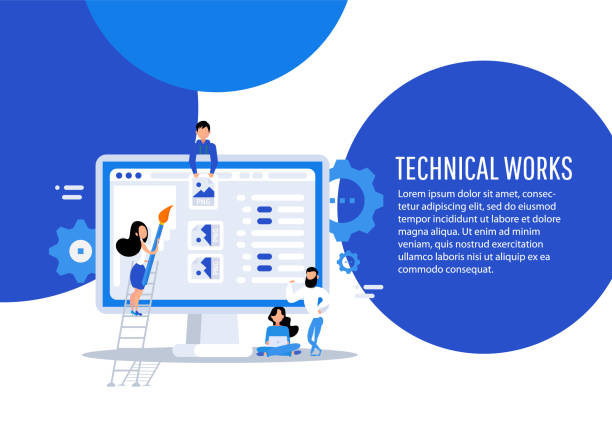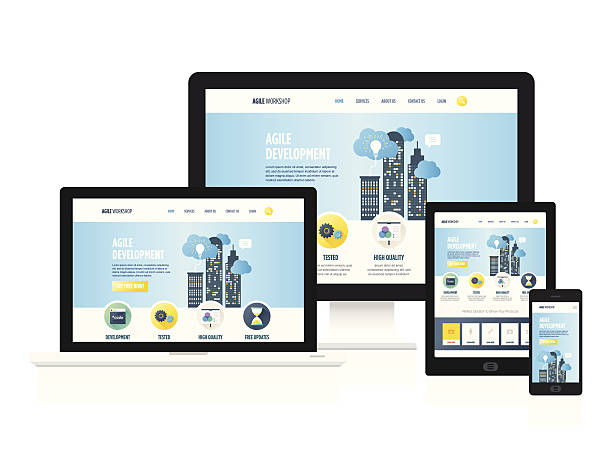What is Responsive Website Design and Why is it Crucial for Every Business?

In today’s world, where smart devices have become an inseparable part of our daily lives, the concept of #Responsive_Website_Design or Responsive Web Design is of paramount importance.
This approach refers to the design and development of websites that can automatically adapt to the dimensions and features of the user’s screen, whether it’s a desktop, laptop, tablet, or smartphone, providing the best possible user experience.
The era of fixed designs, suitable only for large monitors, is over.
Today, a significant portion of web traffic comes from mobile devices, so website flexibility and accessibility across all screen sizes are essential needs, not an option.
This technique, instead of creating multiple separate versions for different devices, writes a single code in such a way that the layout, font sizes, and images change based on the available space.
This not only helps improve the user experience but also saves time and cost in website maintenance.
Ignoring this principle can lead to losing a large portion of the audience and ultimately a decrease in revenue, because #mobile_users quickly abandon sites that do not provide a good experience.
A #modern_responsive_design guarantees an #optimized_user_experience under all conditions and, as such, is considered a cornerstone for digital success in the current era.
Are you tired of losing business opportunities due to lacking a professional corporate website?
Rasaweb, with its professional corporate website design, helps you:
✅ Build a powerful and reliable brand image
✅ Convert website visitors into loyal customers
⚡ Get a free consultation now!
The Evolution of Web Access: From Desktop to Mobile and the Requirements for Adaptation

The world of the internet has undergone fundamental changes over the last two decades.
Initially, websites were primarily designed for display on large desktop monitors, and no one imagined that one day most users would access the internet through devices with much smaller screens.
However, with the advent of smartphones and tablets, the pattern of internet consumption was transformed.
Today, a significant portion of searches, online purchases, and social interactions are conducted via mobile.
This transformation has made the need for responsive web design an undeniable necessity.
Websites optimized only for desktop appear unreadable, cumbersome, and inefficient on mobile devices.
This negative user experience not only leads to user dissatisfaction but can also increase the bounce rate and directly negatively impact website rankings in search engines.
Google has explicitly stated that it prioritizes mobile-friendly websites in its search results.
Therefore, for any business seeking to survive and grow in the digital space, adapting to these changes and implementing a principled and responsive website design is crucial.
This adaptation is not just a choice; it is a prerequisite for retaining audience and competitiveness in today’s market.
Core Principles and Technologies in Responsive Web Design

The foundation of any successful responsive website design rests on three main pillars: Media Queries, Flexible Grids, and Fluid Images.
Media Queries are the heart of responsive design; this CSS feature allows developers to apply different styles based on user device characteristics such as screen width, orientation (horizontal or vertical), and even resolution.
For example, it can be set that a column on desktop moves below another column on mobile.
Flexible grids mean using relative units like percentages (%) instead of fixed pixel (px) units to define the width and height of elements.
This ensures that the website layout automatically adapts to any screen size and fills the available space optimally.
Fluid images also work on the same principle; by setting `max-width: 100%` for images, it is ensured that the image never exceeds its parent container while appropriately shrinking or expanding to fill the available space.
Proper implementation of these principles guarantees a seamless and optimized user experience across all devices.
The importance of responsive website design in ensuring proper content accessibility and performance on any platform is undeniable.
Table 1: Common Breakpoints in Responsive Design
| Screen Width (Pixels) | Common Device Type | Description |
|---|---|---|
| Less than 600px | Small Mobile Phones | Single-column layout and maximum simplicity |
| 600px – 991px | Tablets (Portrait), Large Mobile Phones | Two-column layout, collapsible navigation menu |
| 992px – 1199px | Laptops, Small Desktops | Classic layouts with multiple columns |
| 1200px and more | Large Desktops and Wide Displays | Utilizing all available space, more complex layouts |
Benefits of Responsive Website Design for SEO and User Experience

One of the most important reasons why every website should utilize the responsive website design approach is its positive impact on search engine optimization (SEO) and user experience (UX) improvement.
From an SEO perspective, Google and other search engines rank websites that display well across all devices higher.
Having a single URL for all versions of the site (instead of separate m.site.com versions) simplifies SEO management and prevents duplicate content issues.
This helps search engines crawl and index your content more efficiently.
Furthermore, responsive sites generally have a lower bounce rate, as users encounter a smooth and optimized user experience and do not need to switch devices or zoom in on the page.
From a user experience perspective, a responsive site allows users to access content without any issues, regardless of the device they are using.
This means easy navigation, high readability, and faster loading times.
When users can easily find the information they need and interact with the website, the likelihood of them returning and becoming loyal customers increases.
Responsive web design guarantees content accessibility for everyone, and this is crucial not only for SEO but also for the overall credibility and success of your online business.
Tired of losing business opportunities due to lacking a professional corporate website? Worry no more! With Rasaweb’s corporate website design services:
✅ Your brand’s credibility and professionalism will increase.
✅ You will attract more customers and sales leads.
⚡ Get a free consultation now to get started!
Common Challenges and Solutions in Implementing Responsive Design

Although responsive website design offers numerous benefits, its implementation also comes with challenges.
One of the biggest challenges is performance management on mobile devices.
Large images and heavy CSS/JavaScript files can slow down loading times on mobile networks, even if the layout is responsive.
The solution to this problem is using techniques such as image compression, lazy loading for images and videos, and code optimization.
Another challenge is designing complex navigation for small screens.
Traditional menus that work well on desktop may occupy too much space or become unusable on mobile.
Solutions like hamburger menus, dropdown menus, or tabbed navigation can resolve this issue.
Compatibility with old and legacy content can also be difficult, especially for large websites with years of content.
In such cases, significant portions of the code might need to be rewritten or modified.
Testing and debugging across different devices also pose a challenge; to ensure the website functions correctly on a wide range of devices, using simulators, browser developer tools, and even physical devices is essential.
Overcoming these challenges requires technical knowledge, meticulous planning, and attention to detail, but the final result—an efficient and responsive website—is well worth the effort.
Successful implementation of responsive website design requires up-to-date knowledge and tools.
Responsive Design vs. Mobile-First Approach: Differences and Best Practices

In discussions related to responsive website design, there are two main approaches: “Responsive Design” and “Mobile-First” (Mobile-First).
Although both aim to provide an optimized user experience across different devices, there are significant philosophical and operational differences between them.
Responsive Design means that you start your design from larger screens (usually desktop) and then, using media queries, adjust and simplify the layout for smaller sizes like tablets and mobile.
This approach is usually described as “Graceful Degradation”.
In contrast, Mobile-First is a design approach where you first begin designing and developing the website for the smallest screen (mobile).
After ensuring proper functionality and appearance on mobile, you gradually “enhance” the layout for tablets and then desktops by adding more features and elements.
This approach is known as “Progressive Enhancement”.
The main advantage of Mobile-First is that it forces you to think about the core of the website when prioritizing content and performance.
This leads to faster loading and a better user experience on mobile, which is crucial given the high statistics of mobile usage.
Google also prioritizes the Mobile-First approach in its indexing.
Although both approaches can result in a responsive website, Mobile-First often achieves more optimized and faster results on mobile devices.
The choice between the two depends on project needs and the development team, but in many cases, the Mobile-First approach is recommended as the best practice.
Tools and Frameworks for Responsive Development

To facilitate and accelerate the process of responsive website design, developers use various tools and frameworks.
These tools provide a set of ready-made CSS and JavaScript codes that significantly simplify the implementation of responsiveness principles.
Bootstrap is undoubtedly the most popular and widely used CSS and JavaScript framework for responsive development.
This framework offers a 12-column grid system, pre-built UI components (such as buttons, forms, navigations), and JavaScript plugins that greatly accelerate the creation of responsive websites.
Using Bootstrap is suitable for both beginners and professionals due to its excellent documentation and large user community.
Foundation is another powerful framework that gives developers more flexibility and control.
Foundation also provides an advanced grid system and a set of UI patterns for building responsive websites and web applications.
In addition to complete frameworks, native CSS technologies like Flexbox and CSS Grid have also brought a great revolution in how content is arranged and organized in responsive layouts.
Flexbox is excellent for arranging elements in one dimension (row or column), while CSS Grid provides unparalleled power in creating complex two-dimensional layouts (rows and columns simultaneously).
These tools enable developers to implement a complex and responsive website design with high speed and efficiency.
Table 2: Popular Tools and Frameworks for Responsive Design
| Tool/Framework Name | Type | Main Capabilities |
|---|---|---|
| Bootstrap | CSS/JS Framework | 12-column grid system, UI components, JS plugins, fast and easy |
| Foundation | CSS/JS Framework | Advanced grid system, high customizability, suitable for complex projects |
| Flexbox | CSS Module | One-dimensional layout (row or column), space distribution between items, easy alignment |
| CSS Grid | CSS Module | Two-dimensional layout (rows and columns), building complex layouts and grid systems |
| Media Queries | CSS3 Feature | Applying conditional styles based on device characteristics (width, height, orientation) |
Future Trends in Responsive Website Design

The future of responsive website design is not limited to adapting to different screen sizes.
With technological advancements, websites are expected to react not only to screen size but also to more complex user contexts.
Artificial Intelligence (AI) will play an increasing role in personalizing the user experience; websites can dynamically adjust content and layout based on user browsing habits, location, time of day, and even emotional state.
This concept approaches “Adaptive Design” (Adaptive Design), which goes beyond simple responsiveness and leads to more intelligent changes in the user interface.
Augmented Reality (AR) and Virtual Reality (VR) are also entering the web world, pushing the need for responsive website design to new dimensions.
Imagine a website that can optimize its 3D content based on the user’s device capabilities, from a regular browser to a VR headset.
This will create new challenges in performance optimization and user experience.
Additionally, trends such as Dark Mode and Micro-interactions that enrich the user experience also require a responsive approach to ensure compatibility across all environments and devices.
These trends indicate that responsive website design is not a static concept but is continuously evolving to meet the changing needs of users and technologies.
Are you losing business opportunities because of an outdated website? With Rasaweb, permanently solve the problem of not attracting potential customers through your website!
✅ Attract more high-quality leads
✅ Increase brand credibility in the eyes of customers
⚡ Get a free corporate website design consultation
Measuring Success and Iteration in Responsive Website Design

After implementing responsive website design, the work doesn’t end.
Measuring performance and collecting user feedback for continuous improvement is crucial.
Web analytics tools like Google Analytics can provide valuable data about the devices your users are employing, bounce rate by device, time spent on site, and conversion rates.
By analyzing this data, weaknesses can be identified and addressed.
User Testing on various devices also plays an important role.
Observing real users interacting with your website on mobile, tablet, and desktop can provide deep insights into navigation issues, usability, and overall experience that are not attainable through statistical data.
A/B testing can also be useful for comparing different versions of a website section (e.g., the layout of a form or the placement of a call-to-action button) across various devices.
This data-driven approach helps you make better decisions for optimizing your website.
The process of responsive website design is a continuous cycle of design, implementation, measurement, and iteration.
Given the rapid pace of changes in technology and user behavior, a successful responsive website design must always be evolving and improving to meet new needs and provide the best experience to its audience.
Responsive Design: The Backbone of Modern Digital Presence

Ultimately, the importance of responsive website design in today’s digital age cannot be underestimated.
This approach is not just a fleeting trend; it has become an industry standard.
Websites that cannot adapt to any screen size not only offer a poor user experience but will also lose out in SEO competition.
Investing in responsive web design means investing in the future of your business.
This ensures that your website is accessible to a wide range of users, regardless of the device they use, and this accessibility leads to increased traffic, improved engagement, and ultimately business growth.
Given the ever-increasing use of mobile for internet access, overlooking the need for a responsive website can mean losing a huge segment of potential customers.
A responsive site is not only beneficial for users but also benefits developers and business owners by simplifying site management and maintenance.
This approach provides a solid foundation for any successful online presence and allows businesses to have a powerful and impactful presence in today’s fast-paced, multi-device world.
Responsive website design is no longer a choice but an undeniable necessity for any digital entity.
Frequently Asked Questions
| Question | Answer |
|---|---|
| What is Responsive Web Design? | It is a method for designing websites that optimizes the appearance and functionality of the website according to the screen size of the user’s device (mobile, tablet, laptop, etc.). |
| Why is responsive design important? | Due to the increasing use of various devices for internet access, responsive design provides a better user experience, improves website SEO, and reduces maintenance costs. |
| What are the most important responsive design tools? | Media Queries in CSS, use of relative units (such as percentage, em, rem, vw, vh), Fluid Images, and Grid Systems. |
| What role do Media Queries play in responsive design? | Media Queries allow for the application of different CSS styles based on device characteristics (such as screen width, height, orientation, and screen type). |
| What is the Mobile First concept in responsive design? | It is an approach where design and development begin first for the smallest screen (mobile) and then gradually expand to larger screens (tablet, desktop). |
| Does responsive design affect website SEO? | Yes, Google prefers responsive websites because they provide a better user experience and eliminate the need for separate mobile and desktop versions, which helps improve SEO rankings. |
| What does Fluid Layout mean? | It means that the width of page elements is defined using relative units (such as percentages) instead of fixed pixel values, so they automatically adjust as the screen size changes. |
| How are Flexible Images used in responsive design? | By setting `max-width: 100%;` for images in CSS, it is ensured that the image never exceeds its container and maintains its scale as the screen size changes. |
| What are the differences between responsive design and adaptive design? | Responsive design uses a single layout that fluidly adapts to any screen size, while adaptive design uses several fixed, predefined layouts for specific screen sizes. |
| Are CSS frameworks like Bootstrap useful in responsive design? | Yes, frameworks like Bootstrap have a responsive Grid System and pre-designed components that significantly simplify and speed up the process of building responsive websites. |
And other advertising services of Rasa Web Advertising Agency:
Smart Direct Marketing: Designed for businesses seeking customer behavior analysis through SEO-driven content strategy.
Smart SEO: Designed for businesses looking to increase click-through rates through attractive UI design.
Smart Customer Journey Map: An innovative service to improve SEO ranking through user experience customization.
Smart Brand Identity: An innovative service to enhance campaign management through user experience customization.
Smart Sales Automation: An effective tool for online growth with the help of attractive UI design.
And over hundreds of other services in internet advertising, advertising consultation, and organizational solutions.
Internet Advertising | Advertising Strategy | Advertorials
Resources
- Responsive Design: The Future of Web in Your Hands
- Digital Revolution and its Impact on Website Design
- Comprehensive Guide to Responsive Website Design
- Digital Transformation and its Role in Web Development
? To boost your business in the digital world and reach the pinnacle of success, Rasaweb Afarin Digital Marketing Agency, specializing in e-commerce website design and comprehensive marketing strategies, is with you to experience a powerful and profitable presence.
📍 Tehran, Mirdamad Street, next to Bank Markazi, Kazeroun Jonoubi Alley, Ramin Alley, No. 6



